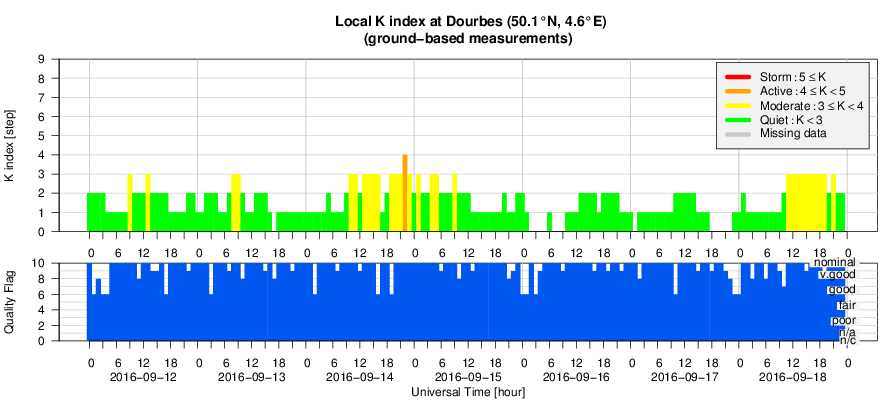- Table of Content
- 1.Farside erupti...
- 2.PROBA2 Observa...
- 3.Review of sola...
- 4.The Internatio...
- 5.Review of geom...
- 6.Geomagnetic Ob...
- 7.Review of iono...
- 8.Future Events
- 9.New documents ...
2. PROBA2 Observations (12 Sep 2016 - 18 Sep 2016)
3. Review of solar activity
4. The International Sunspot Number
5. Review of geomagnetic activity
6. Geomagnetic Observations at Dourbes (12 Sep 2016 - 18 Sep 2016)
7. Review of ionospheric activity (12 Sep 2016 - 18 Sep 2016)
8. Future Events
9. New documents in the European Space Weather Portal Repository
Farside eruption
For the second consecutive week, no C-class flares were observed from Earth. In fact, not a single C-class flare has been recorded so far this September month, with the last C-class event dating back already from late on 31 August. Records will not be broken soon though, as the longest period without a C-class flare was set during the past solar cycle minimum from 3 April till 3 November 2008 (213 days!).
Fortunately, the Sun's farside displayed a bit more activity, with a strong eruption in old active region NOAA 2580 late on 14 September. NOAA 2580 was a relatively simple sunspot region when it transited the solar disk from 22 August till 2 September, showing already a relatively important group filament visible in dedicated solar filters (GONG, http://halpha.nso.edu/ ; left image). The middle and right images underneath compare the solar disk seen in extreme ultraviolet (EUV) resp. late on 29 August (SDO/AIA 193 ; http://sdo.gsfc.nasa.gov/) and early on 14 September (STEREO-A/EUVI 195). As the solar axis is currently tilted towards the Earth, and STEREO-A (ST-A ; https://stereo.gsfc.nasa.gov/beacon/) being at the farside of the Sun, this spacecraft currently sees a bit more of the southern solar hemisphere making all solar structures shifted towards the north in comparison with imagery from Earth's point of view. Nonetheless, enough solar structures (coronal holes) can be recognized to clearly identify the source of the eruption as old active region NOAA 2580.

Prior to the eruption, the region showed a 15-degrees long S-shaped group filament with another 5-degrees long filament close to the west and in parallel. Starting around 22:30UT on 14 September, the latter violently erupted, being accompanied by a small EUV flare, coronal dimming which was particular strong to the east of the region, and a series of post-eruption coronal loops ("arcade") lasting well into 16 September. See EUV imagery underneath, comparing a pre- (20:00UT) and post-event (02:10UT) image of the blast area.
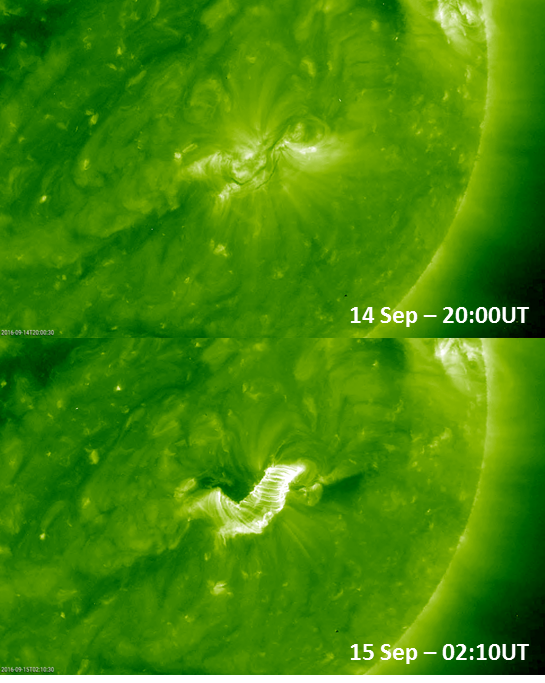
The EUV imagery also showed a faint coronal wave, somewhat interacting with the coronal holes to the northeast. ST-A's SWAVES instrument captured a strong radio-burst, and the IMPACT instrument recorded a modest 100-fold increase in the 10 MeV particle flux (orange curve). The radio-burst was also detected by the Wind spacecraft, which operates from the L1 Lagrange point 1.5 million km upstream from Earth. The GOES spacecraft, operating from their geostationary orbit about 36.000 km above the Earth's surface, did not detect any enhancement in the greater than 10 MeV proton particle flux.

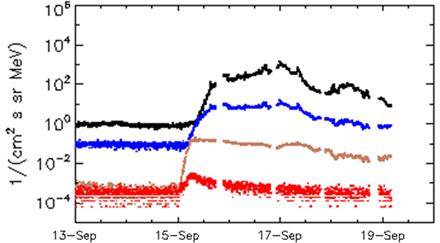
From the above observations, it was clear that a coronal mass ejection (CME) was associated with this event. This CME was observed by both the SOHO/LASCO instrument (http://sohowww.nascom.nasa.gov/ ) as the ST-A/COR instruments. According to CACTus (http://sidc.oma.be/cactus/catalog.php ), the CME's plane-of-the-sky speed (as seen from Earth) was near 750 km/s. The ST-A/COR2 instrument observed a partial halo CME, with the bulk of the CME heading to the southwest but also with a clear ST-A directed component. The CME arrived at ST-A about 62 hours later, i.e. shortly after noon on 17 September. Solar wind speed jumped from about 500 km/s to values in the upper 600 km/s, with Bz briefly peaking at a modest -11 nT.
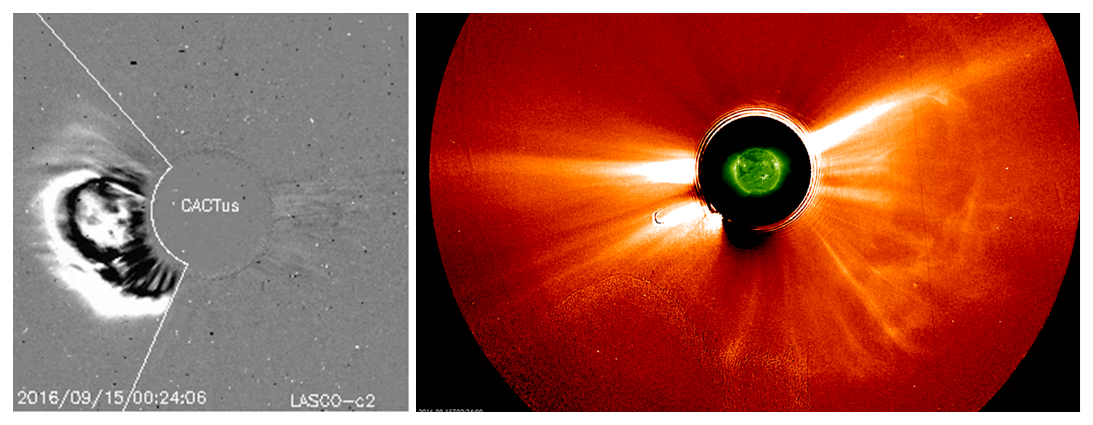
A movie of the aforementioned eruption features can be found at https://youtu.be/Wfis5sassvc . Meanwhile, the active region has rounded the east limb (as seen from Earth) as a spotless faculae area. Interestingly, the main filament still seems to be present as it was prominently visible in the latest H-alpha imagery from the GONG H-alpha Network. It will be interesting to see if we are in for an "encore performance"...
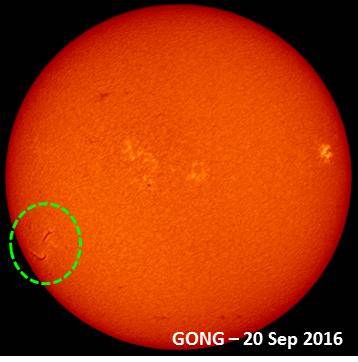
PROBA2 Observations (12 Sep 2016 - 18 Sep 2016)
Solar Activity
Solar flare activity fluctuated between quiet and very low during the week.
In order to view the activity of this week in more detail, we suggest to go to the following website from which all the daily (normal and difference) movies can be accessed: http://proba2.oma.be/ssa
This page also lists the recorded flaring events.
A weekly overview movie can be found at
http://proba2.oma.be/swap/data/mpg/movies/weekly_movies/weekly_movie_2016_09_12.mp4 (SWAP week 338).
Details about some of this week’s events, can be found further below.
If any of the linked movies are unavailable they can be found in the P2SC movie repository at
http://proba2.oma.be/swap/data/mpg/movies/
Tuesday 13
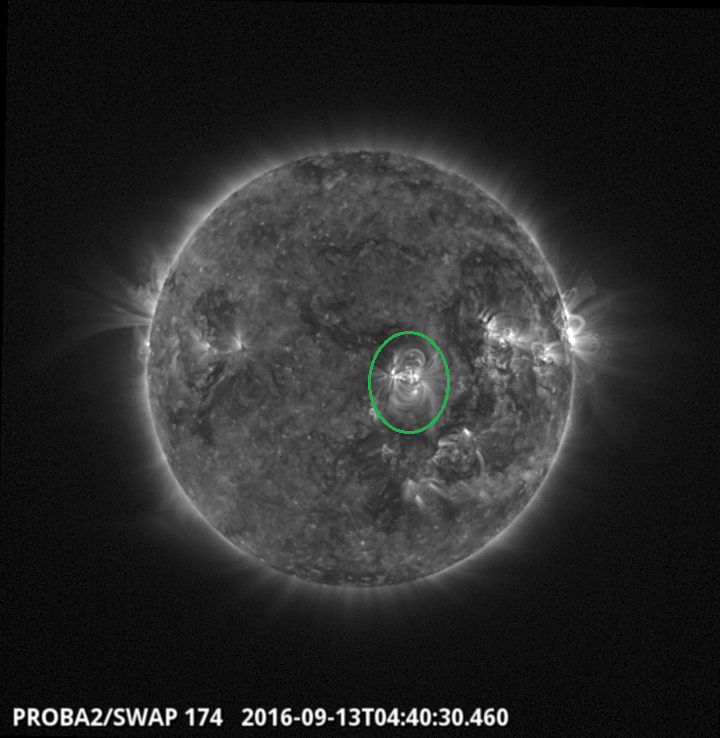
From Sept 13 to Sept 14, the weekly SWAP movie shows sunspot group 2591 producing B-flares. This AR was located close to the central meridian on Sept 13 .
Find a movie of the begin of flaring at
http://proba2.oma.be/swap/data/mpg/movies/20160913_swap_movie.mp4 (SWAP movie).
Sunday Sep 18
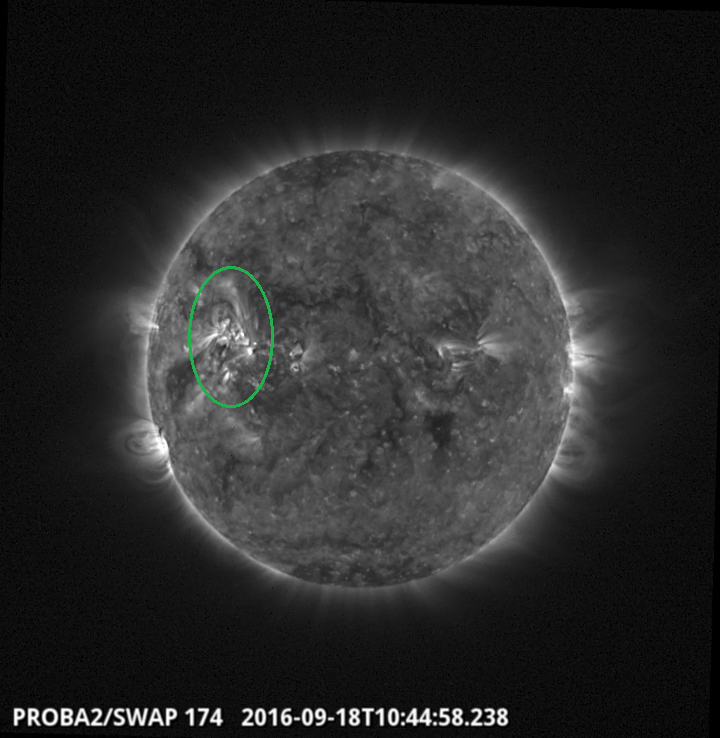
A B6.8 flare originated from sunspot group 2592 located in the Eastern Hemisphere. The peak time was 11:00 UT.
Find a movie of the events at
http://proba2.oma.be/swap/data/mpg/movies/20160918_swap_movie.mp4 (SWAP movie).
Review of solar activity
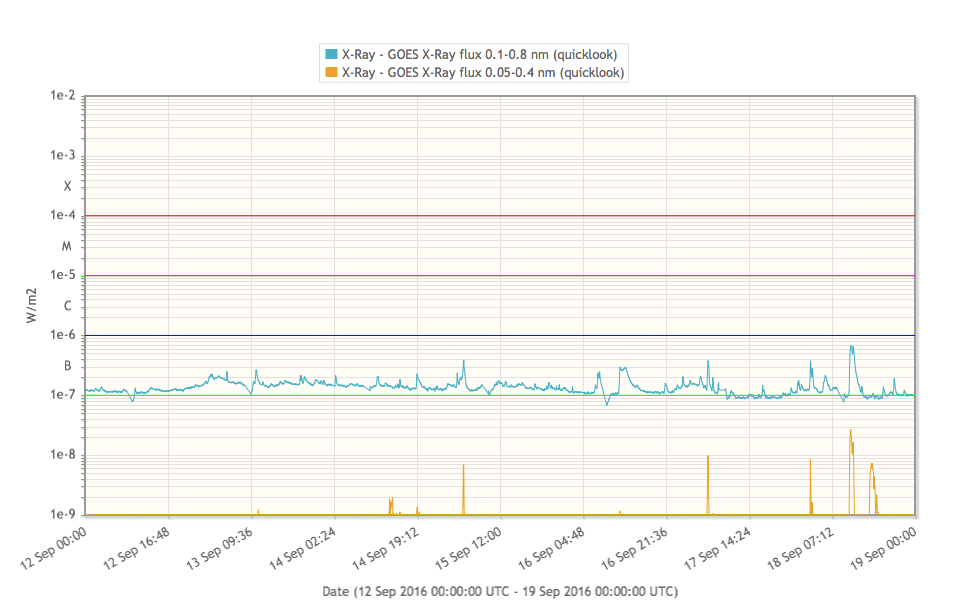
Solar flaring activity was restricted to B-class level. NOAA 2592 was the most prominent sunspot group on the solar disk. It was the source of most B-flares, including the B7 flares on 18 September.
No earth-directed coronal mass ejections (CME) were observed, however on 14 September there was a backsided filament eruption emerging off the East limb of the Sun with a velocity of 750 km/s.
The International Sunspot Number
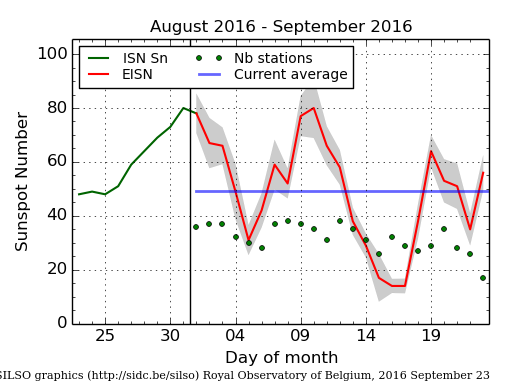
The daily Estimated International Sunspot Number (EISN, red curve with shaded error) derived by a simplified method from real-time data from the worldwide SILSO network. It extends the official Sunspot Number from the full processing of the preceding month (green line). The plot shows the last 30 days (about one solar rotation). The horizontal blue line shows the current monthly average, while the green dots give the number of stations included in the calculation of the EISN for each day.
Review of geomagnetic activity
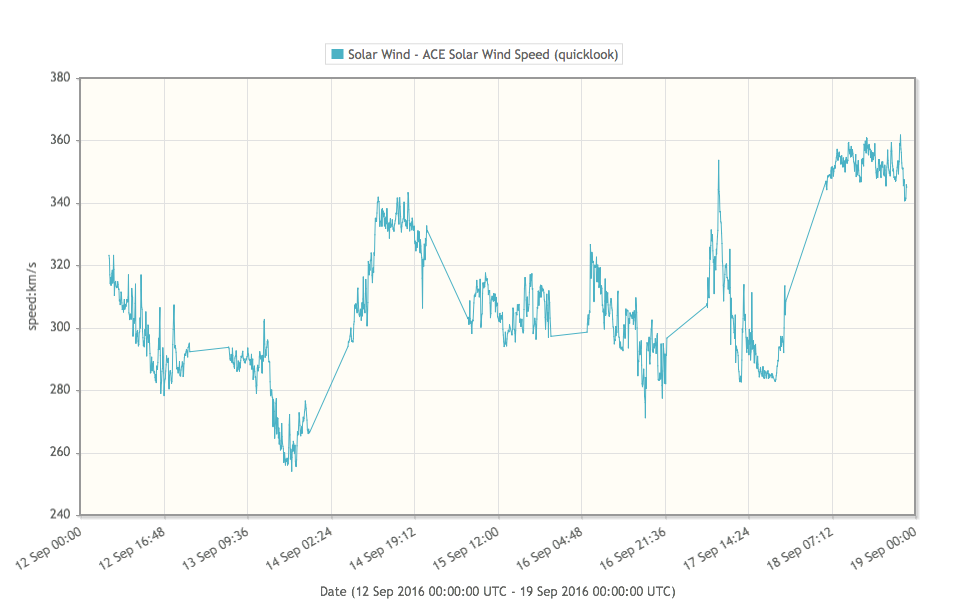
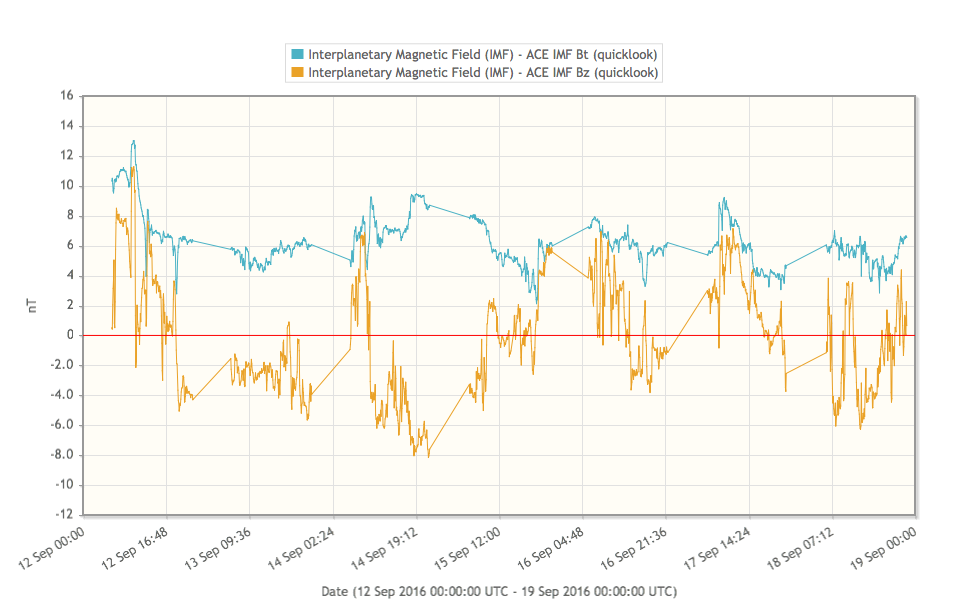
The solar wind parameters didn't vary much. Solar wind speed remained below 360 km/s during most of the time (except 19-Sep-2016 morning, when the speed increased till about 400 km/s. The magnitude of the Interplanetary Magnetic Field (Bt) stayed below 10 nT most of the time (again except morning of 19-Sep-2016) while Bz component were fluctuating between about +-7 nT. The geomagnetic conditions have been quiet (K Dourbes between 0 and 3; NOAA Kp between 0 and 3). No geomagnetic storms were observed. Only once Kp index elevated till Kp=4 on 15-Sep-2016.
Review of ionospheric activity (12 Sep 2016 - 18 Sep 2016)
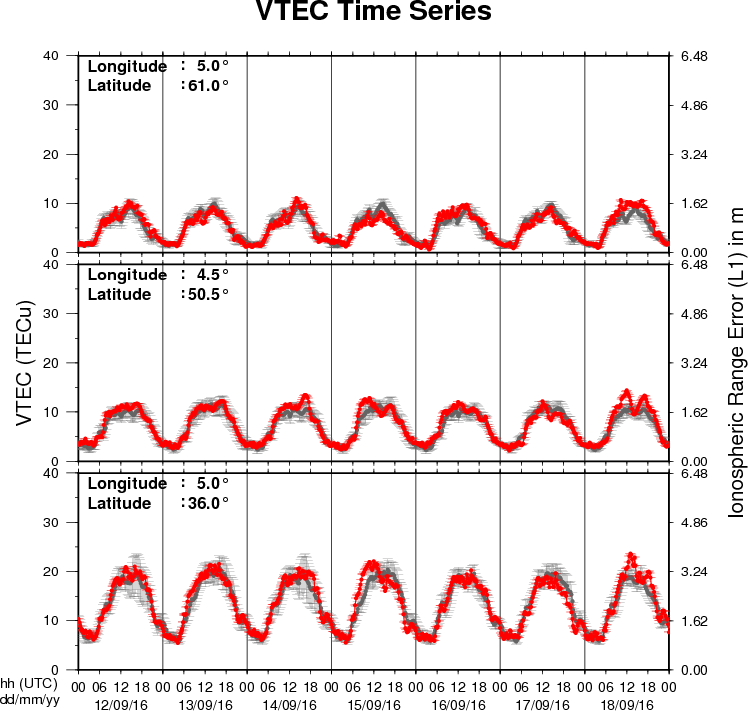
The figure shows the time evolution of the Vertical Total Electron Content (VTEC) (in red) during the last week at three locations:
a) in the northern part of Europe(N61°, 5°E)
b) above Brussels(N50.5°, 4.5°E)
c) in the southern part of Europe(N36°, 5°E)
This figure also shows (in grey) the normal ionospheric behaviour expected based on the median VTEC from the 15 previous days.
The VTEC is expressed in TECu (with TECu=10^16 electrons per square meter) and is directly related to the signal propagation delay due to the ionosphere (in figure: delay on GPS L1 frequency).
The Sun's radiation ionizes the Earth's upper atmosphere, the ionosphere, located from about 60km to 1000km above the Earth's surface.The ionization process in the ionosphere produces ions and free electrons. These electrons perturb the propagation of the GNSS (Global Navigation Satellite System) signals by inducing a so-called ionospheric delay.
See http://stce.be/newsletter/GNSS_final.pdf for some more explanations ; for detailed information, see http://gnss.be/ionosphere_tutorial.php
Future Events
For more details, see http://www.spaceweather.eu/en/event/future
Horizon 2020 Space Work Programme 2018-2020 Stakeholder Consultation Workshop, in Brussels, Belgium
Start : 2016-09-26 - End : 2016-09-28
In the context of preparing the Horizon 2020 Space work
programme 2018-2020, the European Commission organises a dedicated
stakeholder consultation workshop. The main objective of this event
is to further involve all relevant European stakeholders in the
definition of the next Horizon 2020 Space work programme,
highlighting the main priorities and trends.
The participation to the workshop is free and open to all
relevant stakeholders, limited only by the capacity of the
conference rooms. Delegations, European associations and other
stakeholder groups are encouraged to forward this invitation to
their respective constituents and members.
Website:
https://h2020-space-wp-2018-20.teamwork.fr/en/programme
4th Asia Oceania Space Weather Alliance (AOSWA) Workshop, in Jeju, Republic of Korea
Start : 2016-10-24 - End : 2016-10-27
Website:
http://aoswa4.spaceweather.org/index.php
Global Modelling of the Space Weather Chain in Helsinki, Finland
Start : 2016-10-24 - End : 2016-10-28
This event brings together solar, heliospheric, magnetospheric,
and ionospheric communities to discuss the current state and future
challenges in global modelling of the entire space weather chain.
Major developments in forecasting space weather, and understanding
the effects of solar eruptions requires increased communication and
collaboration of these often rather distinct communities. We
welcome submissions from these modelling communities and also
synergetic studies utilising both observations and numerical
models.
Website:
https://pnst.ias.u-psud.fr/sites/pnst/files/global_modelling_space_weather_oct2016.pdf
European Space Weather Week in Ostend, Belgium
Start : 2016-11-14 - End : 2016-11-18
The ESWW is the main annual event in the European Space Weather
calendar. It is the European forum for Space Weather as proven by
the high attendance to the past editions. The agenda will be
composed of plenary/parallel sessions, working meetings and
dedicated events for service end-users. The ESWW will again adopt
the central aim of bringing together the diverse groups in Europe
working on different aspects of Space Weather.
Website:
http://www.stce.be/esww13/
4th SOLARNET Meeting: The Physics of the Sun from the Interior to the Outer Atmosphere, in Lanzarote (Spain)
Start : 2017-01-16 - End : 2017-01-20
The IV SOLARNET MEETING 'The physics of the Sun from the
interior to the outer atmosphere' will take place in Lanzarote
(Spain) from 16th to 20th of January 2017, organized by the
Instituto de AstrofÃsica de Canarias (IAC).
SOLARNET (High-resolution Solar Physics Network) is an EU-FP7
project coordinated by IAC with the aim of bringing together and
integrating the major European research infrastructures in the
field of high-resolution solar physics. SOLARNET involves all
pertinent European research institutions, infrastructures, and data
repositories. Networking activities, access to first-class
infrastructures and joint research and development activities are
being covered under SOLARNET to improve, in quantity and quality,
the service provided by this European community.
The purpose of this conference is to provide a coherent picture
of the Sun as a single physical system playing all the underlying
physical processes measured and observed in the solar atmosphere to
date.
Website:
http://www.iac.es/congreso/solarnet-4meeting/
Solar Orbiter Workshop 7: Exploring the solar environs in Granada, Spain
Start : 2017-04-03 - End : 2017-04-06
This event will be hosted by the Instituto de Astrofisica de
Andalucia - CSIC. Please mind that on April 7th the 20th SWT
meeting will take place at the same venue.
Website: Unkown
New documents in the European Space Weather Portal Repository
See http://www.spaceweather.eu/en/repository
STCE - Het Solar Indices Data analysis Center: De voorspelling van het Ruimteweer
Generalities on Space Weather; SIDC SW forecast team (who, what, how, tools, products).
Given to the solar section of the VVS on 4 June 2016. 20 participants.
http://www.spaceweather.eu/en/repository/show?id=608
STCE - Het nieuwe zonnevlekkengetal: Een kleine samenvatting van een grote verandering
History of the sunspot number; reasons for revision; methodology; major changes and why; consequences on solar cycle and scientific research; group number changes; the new SILSO outlook.
Given to the solar section of the VVS on 4 June 2016. 20 participants.
http://www.spaceweather.eu/en/repository/show?id=609
STCE - Zonneactiviteit en ruimteweer tijdens zonnecyclus 24
General introduction to sunspots, solar cycle, solar eruptions, space weather, major solar storms (history), SIDC and SW prediction, major solar storms during current solar cycle (SC24) and SWx effects.
Given to the VVS / De Sterrenjutters (Koksijde, Belgium) on 2 September 2016. 20 participants.
http://www.spaceweather.eu/en/repository/show?id=610
